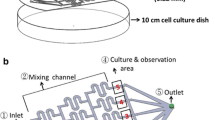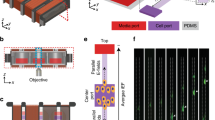Abstract
Tumor metastasis is the primary cause of cancer death. Numerous studies have demonstrated the electrotactic responses of various cancer cell types, and suggested its potential implications in metastasis. In this study, we used a microfluidic device to emulate endogenous direct current electric field (dcEF) environment, and studied the electrotactic migration of non-small cell lung cancer cell lines (H460, HCC827, H1299, and H1975) and the underlying mechanisms. These cell lines exhibited greatly different response in applied dcEFs (2–6 V/cm). While H460 cells (large cell carcinoma) showed slight migration toward cathode, H1299 cells (large cell carcinoma) showed increased motility and dcEF-dependent anodal migration with cell reorientation. H1975 cells (adenocarcinoma) showed dcEF-dependent cathodal migration with increased motility, and HCC827 cells (adenocarcinoma) responded positively in migration speed and reorientation but minimally in migrating directions to dcEF. Activation of MAPK and PI3K signaling pathways was found to be associated with the realignment and directed migration of lung cancer cells. In addition, both Ca2+ influx through activated stretch-activated calcium channels (SACCs) (but not voltage-gated calcium channels, VGCCs) and Ca2+ release from intracellular storage were involved in lung cancer cell electrotactic responses. The results demonstrated that the microfluidic device provided a stable and controllable microenvironment for cell electrotaxis study, and revealed that the electrotactic responses of lung cancer cells were heterogeneous and cell-type dependent, and multiple signals contributed to lung cancer cells electrotaxis.










Similar content being viewed by others
References
Siegel R, Ma J, Zou Z, Jemal AR. Cancer statistics, 2014. CA Cancer J Clin. 2014;64:9–29. doi:10.3322/caac.21208.
Perlikos F, Harrington KJ, Syrigos KN. Key molecular mechanisms in lung cancer invasion and metastasis: prehensive review. Crit Rev Oncol Hematol. 2013;87(1):1–11. doi:10.1016/j.critrevonc.2012.12.007.
Hanahan D, Weinberg RA. Hallmarks of cancer: the next generation. Cell. 2011;144(5):646–74. doi:10.1016/j.cell.2011.02.013.
Steeg PS. Angiogenesis inhibitors: motivators of metastasis? Nat Med. 2003;9(7):822–3. doi:10.1038/nm0703-822.
Polacheck WJ, Zervantonakis IK, Kamm RD. Tumor cell migration in complex microenvironments. Cell Mol Life Sci. 2013;70(8):1335–56. doi:10.1007/s00018-012-1115-1.
Polacheck WJ, Charest JL, Kamm RD. Interstitial flow influences direction of tumor cell migration through competing mechanisms. Proc Natl Acad Sci U S A. 2011;108(27):11115–20. doi:10.1073/pnas.1103581108.
Cohen DJ, Nelson WJ, Maharbiz MM. Galvanotactic control of collective cell migration in epithelial monolayers. Nat Mater. 2014;13(4):409–17. doi:10.1038/nmat3891.
Borgens RB, Roederer E, Cohen MJ. Enhanced spinal cord regeneration in lamprey by applied electric fields. Science. 1981;213(4508):611–7. doi:10.1126/science.7256258.
Nuccitelli R. Physiological electric fields can influence cell motility, growth, and polarity. Adv Cell Biol. 1988;2:213–33. doi:10.1016/S1569-2558(08)60435-X.
McCaig CD, Rajnicek AM, Song B, Zhao M. Controlling cell behavior electrically: current views and future potential. Physiol Rev. 2005;85(3):943–78. doi:10.1152/physrev.00020.2004.
Cuzick J, Holland R, Barth V, Davies R, Faupel M, Fentiman I, et al. Electropotential measurements as a new diagnostic modality for breast cancer. Lancet. 1998;352(9125):359–63. doi:10.1016/S0140-6736(97)10002-2.
Mycielska ME, Djamgoz MB. Cellular mechanisms of direct-current electric field effects: galvanotaxis and metastatic disease. J Cell Sci. 2004;117(9):1631–9. doi:10.1242/jcs.01125.
McCaig CD, Song B, Rajnicek AM. Electrical dimensions in cell science. J Cell Sci. 2009;122(23):4267–76. doi:10.1242/jcs.023564.
Pu J, McCaig CD, Cao L, Zhao Z, Segall JE, Zhao M. EGF receptor signalling is essential for electric-field-directed migration of breast cancer cells. J Cell Sci. 2007;120(19):3395–403. doi:10.1242/jcs.002774.
Li J, Lin F. Microfluidic devices for studying chemotaxis and electrotaxis. Trends Cell Biol. 2011;21(8):489–97. doi:10.1016/j.tcb.2011.05.002.
Sun YS, Peng SW, Lin KH, Cheng JY. Electrotaxis of lung cancer cells in ordered three-dimensional scaffolds. Biomicrofluidics. 2012;6(1):014102. doi:10.1063/1.3671399.
Song S, Han H, Ko UH, Kim J, Shin JH. Collaborative effects of electric field and fluid shear stress on fibroblast migration. Lab Chip. 2013;13(8):1602–11. doi:10.1039/c3lc41240g.
Huang CW, Cheng JY, Yen MH, Young TH. Electrotaxis of lung cancer cells in a multiple-electric-field chip. Biosens Bioelectron. 2009;24(12):3510–6. doi:10.1016/j.bios.2009.05.001.
Wang CC, Kao YC, Chi PY, Huang CW, Lin JY, Chou CF, et al. Asymmetric cancer-cell filopodium growth induced by electric-fields in a microfluidic culture chip. Lab Chip. 2011;11(4):695–9. doi:10.1039/c0lc00155d.
Fang KS, Ionides E, Oster G, Nuccitelli R, Isseroff RR. Epidermal growth factor receptor relocalization and kinase activity are necessary for directional migration of keratinocytes in DC electric fields. J Cell Sci. 1999;112(12):1967–78.
Zhao M, Pu J, Forrester JV, McCaig CD. Membrane lipids, EGF receptors, and intracellular signals colocalize and are polarized in epithelial cells moving directionally in a physiological electric field. FASEB J. 2002;16(8):857–9. doi:10.1096/fj.01-0811fje.
Yan X, Han J, Zhang Z, Wang J, Cheng Q, Gao K, et al. Lung cancer A549 cells migrate directionally in dc electric fields with polarized and activated EGFRs. Bioelectromagnetics. 2009;30(1):29–35. doi:10.1002/bem.20436.
Tsai HF, Huang CW, Chang HF, Chen JJ, Lee CH, Cheng JY. Evaluation of EGFR and RTK signaling in the electrotaxis of lung adenocarcinoma cells under direct-current electric field stimulation. PLoS ONE. 2013;8(8):e73418. doi:10.1371/journal.pone.0073418.
Kao YC, Hsieh MH, Liu CC, Pan HJ, Liao WY, Cheng JY, et al. Modulating chemotaxis of lung cancer cells by using electric fields in a microfluidic device. Biomicrofluidics. 2014;8(2):024107. doi:10.1063/1.4870401.
Khatib L, Golan DE, Cho M. Physiologic electrical stimulation provokes intracellular calcium increase mediated by phospholipase C activation in human osteoblasts. FASEB J. 2004;18(15):1903–5. doi:10.1096/fj.04-1814fje.
Wu D, Ma X, Lin F. DC electric fields direct breast cancer cell migration, induce EGFR polarization, and increase the intracellular level of calcium ions. Cell Biochem Biophys. 2013;67(3):1115–25. doi:10.1007/s12013-013-9615-7.
Trollinger DR, Isseroff RR, Nuccitelli R. Calcium channel blockers inhibit galvanotaxis in human keratinocytes. J Cell Physiol. 2002;193(1):1–9. doi:10.1002/jcp.10144.
Palmer AM, Messerli MA, Robinson KR. Neuronal galvanotropism is independent of external Ca(2+) entry or internal Ca(2+) gradients. J Neurobiol. 2000;45(1):30–8.
Titushkin IA, Rao VS, Cho M. Mode- and cell-type dependent calcium responses induced by electrical stimulus. IEEE Transactions on Plasma Science. 2004;32(4):1614–9.
Sun S, Titushkin I, Cho M. Regulation of mesenchymal stem cell adhesion and orientation in 3D collagen scaffold by electrical stimulus. Bioelectrochemistry. 2006;69(2):133–41. doi:10.1016/j.bioelechem.2005.11.007.
Sauer H, Stanelle R, Hescheler J, Wartenberg M. The DC electrical-field-induced Ca2+ response and growth stimulation of multicellular tumor spheroids are mediated by ATP release and purinergic receptor stimulation. J Cell Sci. 2002;115(16):3265–73.
Li F, Chen T, Hu S, Lin J, Hu R, Feng H. Superoxide mediates direct current electric field-induced directional migration of glioma cells through the activation of AKT and ERK. PLoS ONE. 2013;8(4):e61195. doi:10.1371/journal.pone.0061195.
Sato MJ, Kuwayama H, van Egmond WN, Takayama AL, Takagi H, van Haastert PJ, et al. Switching direction in electric-signal-induced cell migration by cyclic guanosine monophosphate and phosphatidylinositol signaling. Proc Natl Acad Sci U S A. 2009;106(16):6667–72. doi:10.1073/pnas.0809974106.
Ozkucur N, Perike S, Sharma P, Funk RH. Persistent directional cell migration requires ion transport proteins as direction sensors and membrane potential differences in order to maintain directedness. BMC Cell Biol. 2011;12:4. doi:10.1186/1471-2121-12-4.
Titushkin I, Cho M. Regulation of cell cytoskeleton and membrane mechanics by electric field: role of linker proteins. Biophys J. 2009;96(2):717–28. doi:10.1016/j.bpj.2008.09.035.
Rajnicek AM, Foubister LE, McCaig CD. Temporally and spatially coordinated roles for Rho, Rac, Cdc42 and their effectors in growth cone guidance by a physiological electric field. J Cell Sci. 2006;119(9):1723–35. doi:10.1242/jcs.02896.
Liu Q, Song B. Electric field regulated signaling pathways. Int J Biochem Cell Biol. 2014;55:264–8. doi:10.1016/j.biocel.2014.09.014.
McCawley LJ, Li S, Wattenberg EV, Hudson LG. Sustained activation of the mitogen-activated protein kinase pathway. A mechanism underlying receptor tyrosine kinase specificity for matrix metalloproteinase-9 induction and cell migration. J Biol Chem. 1999;274(7):4347–53. doi:10.1074/jbc.274.7.4347.
Sasaki AT, Janetopoulos C, Lee S, Charest PG, Takeda K, Sundheimer LW, et al. G protein-independent Ras/PI3K/F-actin circuit regulates basic cell motility. J Cell Biol. 2007;178(2):185–91. doi:10.1083/jcb.200611138.
Zhao M, Song B, Pu J, Wada T, Reid B, Tai G, et al. Electrical signals control wound healing through phosphatidylinositol-3-OH kinase-gamma and PTEN. Nature. 2006;442(7101):457–60. doi:10.1038/nature04925.
Liu D, Yi C, Wang K, Fong CC, Wang Z, Lo PK. Reorganization of cytoskeleton and transient activation of Ca2+ channels in mesenchymal stem cells cultured on silicon nanowire arrays. ACS Appl Mater Interfaces. 2013;5(24):13295–304. doi:10.1021/am404276r.
Onuma EK, Hui SW. A calcium requirement for electric field-induced cell shape changes and preferential orientation. Cell Calcium. 1985;6(3):281–92.
Lee J, Ishihara A, Oxford G, Johnson B, Jacobson K. Regulation of cell movement is mediated by stretch-activated calcium channels. Nature. 1999;400(6742):382–6. doi:10.1038/22578.
Acknowledgements
This work was supported by the Research Grants Council of Hong Kong (CRF Project No. CityU9/CRF/13G; GRF Project No. CityU_11303815), the National Key Scientific Research Program (973 Program No. 2012CB933302), the Knowledge Innovation Program of Shenzhen Municipal Government (Grant No. JCYJ20140419115507575; JCYJ20150601102053070), the Outstanding Young Scholars’ Growth Plan in the Colleges and Universities of Liaoning Province (Grant No. LJQ2015067), and the National Natural Science Foundation of China (Grant No. 81201689).
Author information
Authors and Affiliations
Corresponding author
Ethics declarations
Conflict of interest
The authors declare that they have no conflict of interest.
Rights and permissions
About this article
Cite this article
Li, Y., Xu, T., Chen, X. et al. Effects of direct current electric fields on lung cancer cell electrotaxis in a PMMA-based microfluidic device. Anal Bioanal Chem 409, 2163–2178 (2017). https://doi.org/10.1007/s00216-016-0162-0
Received:
Revised:
Accepted:
Published:
Issue Date:
DOI: https://doi.org/10.1007/s00216-016-0162-0




